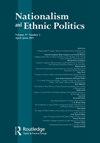Jews and Palestinians in the Late Ottoman Era, 1908–1914: Claiming the Homeland
IF 1.1
Q3 ETHNIC STUDIES
引用次数: 1
Abstract
minating in the Bonn-Copenhagen Declarations (1955). The following chapter by Michael Byram (Durham University) analyzes school, language, and identity in North Schleswig in the 1980s. It is widely accepted that education has a key function in promoting the use of minority language and identity, but in cases of cross-border minorities, the curricula taught must accommodate the narrative and demands of both, the kinand the state of residence. Additionally, German schools in a Danish state faced a challenge that most minority members spoke the regional dialect Sønderjysk (Southern Jutian), neither standard Danish, nor standard German of the states to which they could be linked via ethnopolitical identities. The former principal of one of the Danish high schools in South Schleswig, Jørgen K€ uhl, offers an overview of minority history until 2020, the centenary of border redrawal and reconstitution of German minority in Denmark. He points out that relationships have normalized since 1995 when the chairman of the German minority spoke for the first time at the central lieu-de-memoire in Danish national history, the battle of Dybbøl memorial day. To this effect, K€ uhl argues, the younger generation from the community see no contradiction in pursuing schooling at first in Danish Duborgskolen in South Schleswig and then enrolling in Deutsches Gymnasium Nordschleswig. He concludes that the previously dominant reference of the region’s citizens to either of the nation-states as homelands, has yielded place to a non-state, Schleswig regional identity. The final chapter by Ruairidh Tarvet (Edinburgh University) confirms this observation in the analysis of linguistic identity in the German minority. He demonstrates both the flexibility of code switching in different circumstances and navigation between standard German, standard Danish and the Sønderjysk dialect. This book opens existing historical research on the region in the region’s languages to an international public; it adds to understanding of hitherto unknown aspects of minority identity formation and community consolidation. Yet, much more critical reflection could have been offered in this volume on the dominant presentation of minority history during and its relationship to NS German rule. If anything this reflects on challenges that minority members themselves face in their Vergangenheitsbew€altigung and are increasingly perceived as such by the minority itself.奥斯曼帝国晚期的犹太人和巴勒斯坦人,1908-1914:争夺家园
《波恩-哥本哈根宣言》(1955年)。迈克尔·拜拉姆(杜伦大学)的下一章分析了20世纪80年代北石勒苏益格的学校、语言和身份。人们普遍认为,教育在促进使用少数民族语言和认同方面具有关键作用,但在跨界少数民族的情况下,所教授的课程必须适应居住民族和居住国家的叙述和要求。此外,丹麦国家的德语学校面临着一个挑战,即大多数少数民族成员说的是南jutian方言,既不是标准的丹麦语,也不是通过民族政治身份与他们联系在一起的国家的标准德语。在南石勒苏益格的一所丹麦高中的前校长Jørgen K ø uhl,提供了直到2020年的少数民族历史的概述,这是丹麦的边界重新划定和德国少数民族重建的一百周年。他指出,自1995年德裔少数民族主席首次在丹麦国家历史上的纪念中心——迪布尔战役纪念日——发表讲话以来,两国关系已经正常化。为此,乌尔认为,来自社区的年轻一代认为,首先在南石勒苏益格的丹麦杜博斯科伦学校接受教育,然后进入北石勒苏益格的德意志中学就读,并没有什么矛盾。他的结论是,以前该地区公民将两个民族国家中的任何一个作为家园的主要参考,已经让位给非国家的石勒苏益格地区认同。爱丁堡大学的Ruairidh Tarvet在最后一章对德语少数民族语言认同的分析中证实了这一观察。他展示了在不同情况下代码转换的灵活性,以及在标准德语、标准丹麦语和Sønderjysk方言之间的导航。这本书以该地区的语言向国际公众开放了该地区现有的历史研究;它增加了对迄今为止未知的少数民族身份形成和社区巩固方面的理解。然而,在这本书中,可以提供更多关于少数民族历史的主要表现及其与新德国统治的关系的批判性反思。如果说有什么不同的话,那就是这反映了少数民族成员自己在他们的vergangenheitsbealtigung中所面临的挑战,并且越来越多地被少数民族自己所认识到。
本文章由计算机程序翻译,如有差异,请以英文原文为准。
求助全文
约1分钟内获得全文
求助全文
来源期刊

Nationalism and Ethnic Politics
ETHNIC STUDIES-
CiteScore
1.30
自引率
0.00%
发文量
30
期刊介绍:
Nationalism & Ethnic Politics explores the varied political aspects of nationalism and ethnicity in order to develop more constructive inter-group relations. The journal publishes case studies and comparative and theoretical analyses. It deals with pluralism, ethno-nationalism, irredentism, separatism, and related phenomena, and examines processes and theories of ethnic identity formation, mobilization, conflict and accommodation in the context of political development and "nation-building". The journal compares and contrasts state and community claims, and deal with such factors as citizenship, race, religion, economic development, immigration, language, and the international environment.
 求助内容:
求助内容: 应助结果提醒方式:
应助结果提醒方式:


